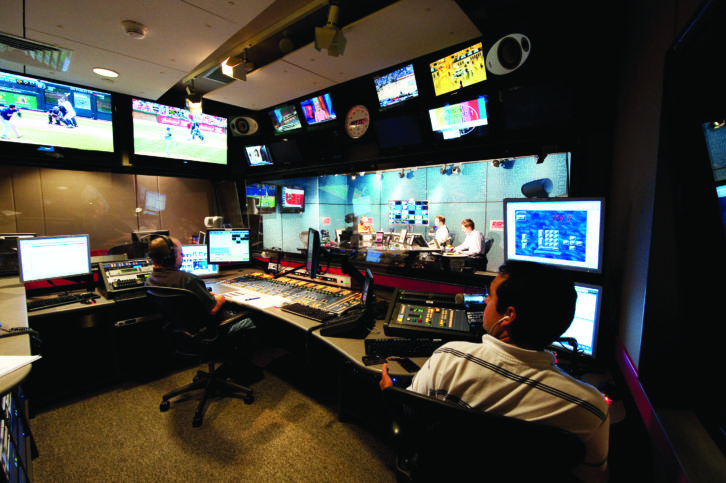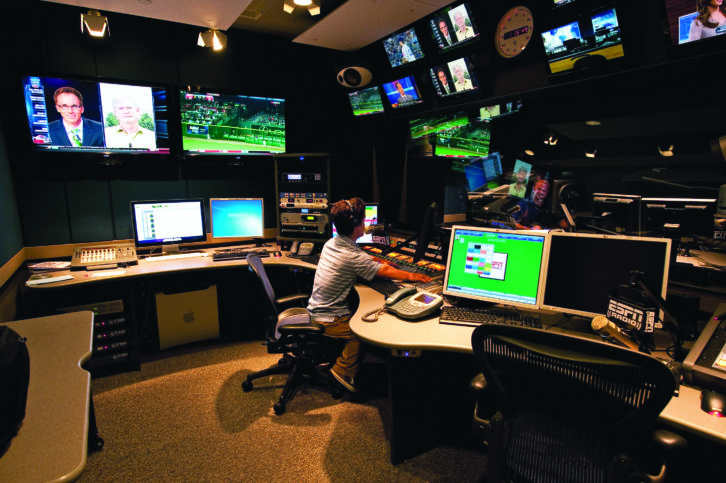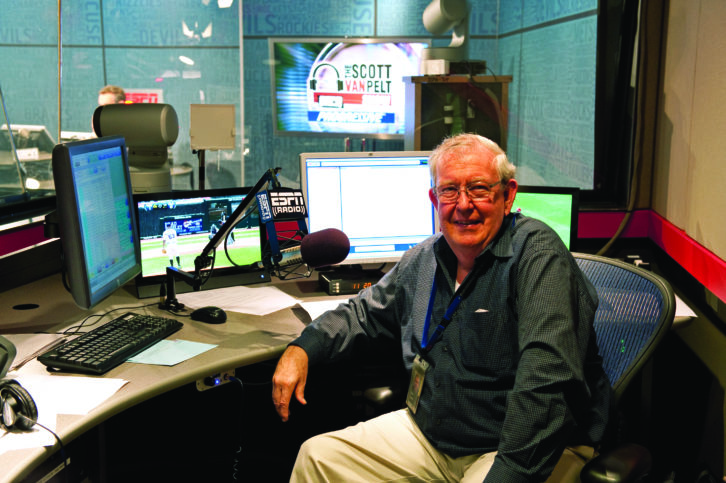ESPN Radio cut a ribbon on new studios on June 1, 2011, completing a project that included talk studios, dedicated control rooms and “SportsCenter” booths.
In its announcement, ESPN stated that visitors “will see how ESPN Radio has grown from simply a terrestrial service to ESPN Audio, a content provider via many platforms.” According to Mo Davenport, senior vice president and general manager of ESPN Radio Network, “ESPN Radio consumers are no longer simply radio listeners.” He said the organization is committed to ensuring that “fans not only get their ESPN Radio content how they want it, but also when they want it, and where they want it.”
The job took 10 months; the budget was not disclosed.
Radio World asked Holly Palmer, senior engineer of media technology, for details, particularly about the data side of the work.

Radio World: Describe the scope of the project.
Holly Palmer: We added six control rooms, two studios, two news booths, a screening room for highlights and a show prep area.
We expanded our existing IT infrastructure by adding a second core switch, updating our domain controllers to new hardware/OS, changed server platforms to a GPFS cluster and added 22 new ENCO Systems workstations. We expanded our existing Sierra Automated Systems 32KD to eight frames and 27 RIOs.

RW: What was the reason for the job?
Palmer: To accommodate the growth in digital, podcasting, remote broadcasts and “Deportes” radio platforms. We took the opportunity to improve our radio/TV facility by redesigning the studio layouts for a better TV presentation.
RW: Who were major equipment and service providers?
Palmer: Meridian Design Associates for architecture; Associated Construction for construction; and Technet for integration. SAS is our router and console manufacturer. ENCO Systems supplies our digital audio software.
Adobe 3.0 and ProTools are the multi-track editing suites. The furniture was designed by Omnirax.

We used Airtools Mic Processors, ElectroVoice RE27 microphones and Visio TVs, as well as products from Telos, Eventide, 25-Seven, Titus Labs, AudioScience, Tannoy, Neutrik, Fostex and Stantron.
RW: Describe the IT infrastructure involved.
Palmer: We have a non-traditional approach to IT support; we actively engage our corporate IT department to assist us in supporting our infrastructure. We work together to support radio as a cross-departmental team. That has allowed us to employ technology not previously possible without their support.
We have our own domain for radio including child, root and DHCP servers. Our network includes two core Cisco switches and four satellite switches. We route across four subnets including two dedicated specifically to equipment. Our more than 90 ENCO software installations run on HP server-class workstations that we designed and support ourselves, in-house. The ENCO databases and audio are stored on a GPFS cluster utilizing a shared Samba environment spread across two buildings, delivering true active-active availability.

We also introduced the concept of multimedia desktops to our environment. These desktops live on our corporate network, have multi-track editing software installed and have access to shared storage for light production, thereby leaving our studios/control rooms available for more intense production.
RW: Who was on the project team?
Palmer: I am the senior engineer, media technology. I am responsible for the IT infrastructure and digital audio systems. Wayne Gignac is the project manager and senior engineer, media systems, supporting our traditional radio infrastructure. The team includes Kevin Plumb, senior director of engineering, and engineers Brian Janes and Bob Gilmore.

It was a true team effort. Kevin provided project direction and oversight. Wayne led the way as project manager, keeping us all moving in the right direction; and he was the key person responsible for the router and consoles. I was responsible for working with IT on our infrastructure and hardware requirements as well as the digital audio programming and automation. Brian Janes was responsible for design and implementation of our new screening room as well as the RTS intercom system. Bob Gilmore was responsible for the TV design and implementation and the multimedia workstations.
RW: Briefly, what is unusual about the facility?
Palmer: We have one of the largest ENCO installations, more than 90 workstations, and one of the largest SAS routers currently online in the U.S. — eight frames, 25 RIOs, with 4,096 inputs by 4,096 out.
We have more than 1,600 command cuts in our ENCO library to facilitate our extensive automation including interfacing with the router, the Crestron system for netcues, the delay units and a system status display we developed in-house call VBOC.
We have Crestron controllers as interfaces to allow us to remote-control our more than 115 TVs in the new area (more than 180 televisions in the combined facility controlled by Crestron).
Radio screening is a major source of audio for newsgathering across the entire campus. To facilitate a shared workflow, we developed an application in-house called ESPNAudio.
ESPNAudio pulls together our 700,000 cuts of audio from our active databases and our archive into one place to allow anyone on campus to access it easily from any corporate workstation.

RW: What were the critical equipment and facility decisions?
Palmer: We had to decide if we were going to expand our exiting SAS and ENCO infrastructure, try something new or build the new facility as a separate installation.
Our decision was to expand our existing infrastructure. That decision was made as a team after a lot of research. We knew that by expanding our already extensive infrastructure, we were taking risks, but together as a team we decided that it was the best way to use our resources. The flexibility it gives us is invaluable.
The other critical decision was to make television a priority in the project. Every decision, from architecture, to placement of equipment in the control rooms was decided with an appreciation for television and an enhancement of the experience for the listener and viewer.
RW: Any experiences with a central new piece of gear or system?
Palmer: This was our first experience with the SAS Rubicon control surfaces. We automate through ENCO, scripts that allow end users in control rooms to “take” news booths. This changes the mappings for the headphones, speakers, talkback and on/off buttons in the news booth to attach it to the control room that took it. We were able to accomplish this using both ENCO command cuts and SAS automation.
RW: What’s the design aesthetic?
Palmer: The area demonstrates a certain “coming of age” moment for the network. As one of our head technologists likes to say, “We’re big now.”

This facility has a serious feel to it. It represents a significant investment in audio by ESPN.
RW: Other unique challenges?
Palmer: It was never far from our minds that we were not only designing a radio studio, we were designing TV space. Because three of our weekday programs are carried on ESPN2 or ESPNU, we had to carefully integrate the needs of TV with the needs of radio. We worked together in a collaborative environment with TV to accomplish this goal.
RW: Who kept the process rolling? Any unexpected crises?
Palmer: Both Wayne and Kevin kept the process rolling; Wayne from a project management standpoint, Kevin from the direction side.
Our challenge came before construction began. We originally specified this project out three years ago, but for a variety of reasons, it was pushed back more than a year. As a result, we had to reimagine what some of the hardware platforms were going to be because many of the originally specified equipment were no longer available.
Additionally, our budget number had changed forcing us to reevaluate some of our choices so we could deliver on our original design at a cost savings. Finally, we experienced significant delay times for some of our key components forcing us to change some of our timelines.












